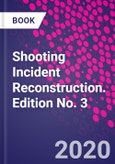Shooting Incident Reconstruction, Third Edition, offers a thorough explanation of matters from simple to complex to help the reader understand the factors surrounding ballistics, trajectory, and shooting scenes.
Forensic scientists, law enforcement, and crime scene investigators are often tasked with reconstruction of events based on crime scene evidence, along with the subsequent analysis of that evidence. The use and misuse of firearms to perpetrate crimes from theft to murder necessitates numerous invitations to reconstruct shooting incidents. The discharge of firearms and the behavior of projectiles create many forms of physical evidence that, through proper testing and interpretation by a skilled forensic scientist, can establish what did and what did not occur.
Written by the world's most well-respected shooting scene and ballistics experts, the book addresses the terminology, science, and factors involved in reconstructing shooting incident events to solve forensic cases. It covers the full range of related topics including: the range from which a firearm was discharged; the sequence of shots in a multiple discharge shooting incident; the position of a firearm at the moment of discharge; and the position of a victim at the moment of impact. The probable flight path of a projectile and the manner in which a firearm was discharged are also discussed. Case studies illustrate real-world application of technical concepts, supported by over 200 full-color diagrams and photographs.
This book will be of value to practicing forensic scientists (firearm and toolmark examiners), ballistics experts, crime scene personnel, police departments, forensic consultants (generalists), attorneys and judges, medical examiners (coroners), and forensic pathologists.
Please Note: This is an On Demand product, delivery may take up to 11 working days after payment has been received.
Table of Contents
1. Case Approach, Philosophy, and Objectives2. Working Shooting Scenes3. The Reconstructive Aspects of Class Characteristics and a Limited Universe4. Is It a Bullet Hole?5. Some Useful Reagents and Their Application6. Distance and Orientation Derived from Gunshot Residue Patterns7. Projectile Penetration and Perforation8. Projectiles and Glass9. Projectile Ricochet and Deflection10. The Principles of "Trajectory" Reconstruction11. Determining Bullet Track in Gunshot Victims12. Trace Evidence Considerations Associate with Firearms13. True Ballistics: Long-Range Shootings and Falling Bullets14. Cartridge Case Ejection and Ejection Patterns15. The Shooting of Motor Vehicles16. Shotgun Shootings and Evidence17. Sound Level of Gunshots, Supersonic Bullets, and Other Impulse Sounds18. Ultimate Objectives, Reports, and Court Presentations
Authors
Michael G. Haag Forensic Scientist, Forensic Science Consultants, Albuquerque, NM, USA. Michael Haag is the Technical Leader in the Firearm & Tool Mark Unit, in the Scientific Evidence Division for the Albuquerque, New Mexico Police Department. Mr. Haag has held this position for over 20 years. In addition, he is also a member of the Albuquerque Police Department Major Crime Scene Team and a Blood Alcohol Analyst.Mr. Haag is a Distinguished Member of the Association of Firearm and Toolmark Examiners (AFTE), is the Editor of AFTE News, Assistant Editor of the AFTE; and a member of the American Academy of Forensic Science (AAFS), the European Network of Forensic Science Institutes (ENSFI), the Southwest Association of Forensic Scientists (SWAFS) and the Association for Crime Scene Reconstruction (ACSR).
Mr. Haag also conducts regular training, seminars and workshops around the world for the AFTE, FBI, IAI, AAFS and ASCLAD, to name a few. Mr. Haag was co-author with his father on the highly successful second edition of Shooting Incident Reconstruction, which published in 2011. Lucien C. Haag Criminalist, Forensic Science Services, Inc., Carefree, AZ, USA. Lucien C. "Luke� Haag is a former Criminalist and Technical Director of the Phoenix Crime Laboratory, with over 53 years of experience in the field of criminalistics and forensic firearms examination. He is the author of the 1st edition of the book, Shooting Incident Reconstruction, 2005 and co-author of the 2nd edition 2011.
Presently he is an independent forensic consultant with his own company, Forensic Science Services, Inc., that provides criminalistics services to prosecutors, public defenders, private attorneys, law enforcement agencies, insurance companies, educational institutions and private individuals.
Luke Haag has a Bachelor of Science degree in chemistry from the University of California at Berkeley with subsequent forensic training at California State University at Long Beach, Indiana University, Arizona State University, the FBI Laboratory, the FBI Forensic Training Facility, and course work in Forensic Microscopy from the McCrone Institute.
In addition to Distinguished Membership status in the AFTE and the California Association of Criminalists, he is a member of the SWAFS, the AAFS, an Associate Member of ENFSI and past board member of the International Wound Ballistics Association.
He has authored and presented over 200 scientific papers, most of which have dealt with various exterior and terminal ballistic properties, effects and behavior of projectiles. His primary area of special interest is the reconstruction of shooting scenes and incidents.








